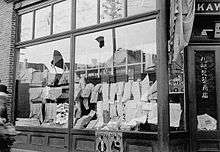Asiatic Exclusion League
The Asiatic Exclusion League, often abbreviated AEL, was an organization formed in the early twentieth century in the United States and Canada that aimed to prevent immigration of people of Asian origin.
United States
The Asiatic Exclusion League was formed as the Japanese and Korean Exclusion League on 14 May 1905 in San Francisco, California, created by 67 labor unions. Among those attending the first meeting were labor leaders (and European immigrants) Patrick Henry McCarthy of the Building Trades Council of San Francisco and Andrew Furuseth and Walter McCarthy of the Sailor's Union. In December 1907, the organization was renamed the Asiatic Exclusion League to include South Asian and Chinese immigrants in their agenda. Advocating for the “white man’s country” ideal and the prohibition of Asian labor immigration, the AEL set up branches across the Pacific coast of North America, achieving transnational status and cross-border labor organization.[1]
Canada

A sister organization with the same name was formed in Vancouver, British Columbia on 12 August 1907 under the auspices of the Trades and Labour Council. Its stated aim was "to keep Oriental immigrants out of British Columbia." [2] On 7 September, riots erupted in Vancouver when League members besieged Chinatown after listening to inflammatory racist speeches at City Hall (then on Main Street near Georgia Street). 4,000 people shouting racist slogans, by the time the riot reached City Hall, it had reached 8,000 people. The crowd marched into Chinatown, vandalizing and causing thousands of dollars' worth of damage. The mob then rampaged through Japantown, where they were confronted by residents armed with clubs and bottles with which they fought back. The organization flourished immediately following the riots, but began to dwindle by the following year.[3] The AEL resurfaced in the early 1920s, this time claiming a membership of 40,000 in the province in the period leading up to the passage of the Chinese Immigration Act of 1923, which ended virtually all Chinese immigration to Canada.[4]
Another important, albeit indirect, consequence of AEL activity was that the 1907 Vancouver riots led to the first drug law in Canada. The Minister of Labour (and future Prime Minister), William Lyon Mackenzie King, was sent to investigate the riots as well as victim claims for compensation. One claim was submitted by opium manufacturers, which sparked an investigation into the local drug scene by King. Particularly alarming to the minister was that opium consumption was apparently spreading to young white women. A federal law was soon passed “prohibiting the manufacture, sale and importation of opium for other than medicinal purposes.” [5]
Both Asiatic Exclusion Leagues were the product of an overall atmosphere of white racism against Asians that prevailed in Canada and the United States from the 1800s on, culminating in the imposition of a head tax and other immigration policies designed to exclude Asians from Canada, as well as Japanese American internment and Japanese Canadian internment during World War II.
See also
- Anti-Jap Laundry League
- Chinese Immigration Act
- Chinese Massacre of 1871
- Patriotic Leagues (Southern Cone)
- Takao Ozawa v. United States
- United States v. Bhagat Singh Thind
- Vancouver anti-Chinese riots, 1886
Notes
- ↑ Chang, Kornel (2012). American Crossroads : Pacific Connections : The Making of the U.S.-Canadian Borderlands. California: University of California Press. p. 106. ISBN 9780520951549 – via ProQuest Ebrary.
- ↑ Vancouver News-Advertiser, 7 September 1907.
- ↑ Peter Ward, White Canada Forever: Popular Attitudes and Public Policy Toward Orientals in British Columbia. 3rd ed. Montreal and Kingston: McGill-Queen’s University Press, 2002, 73.
- ↑ Kay J. Anderson, Vancouver’s Chinatown: Racial Discourse in Canada, 1875-1980. Montreal & Kingston: McGill-Queen’s University Press, 1995, 128.
- ↑ Catherine Carstairs, “‘Hop Heads’ and ‘Hypes’: Drug Use, Regulation and Resistance in Canada, 1920-1961,” PhD thesis, University of Toronto, 2000, 24.
External links
- Asiatic Coolie Invasion on the Virtual Museum of San Francisco.
- History of Metropolitan Vancouver by Chuck Davis